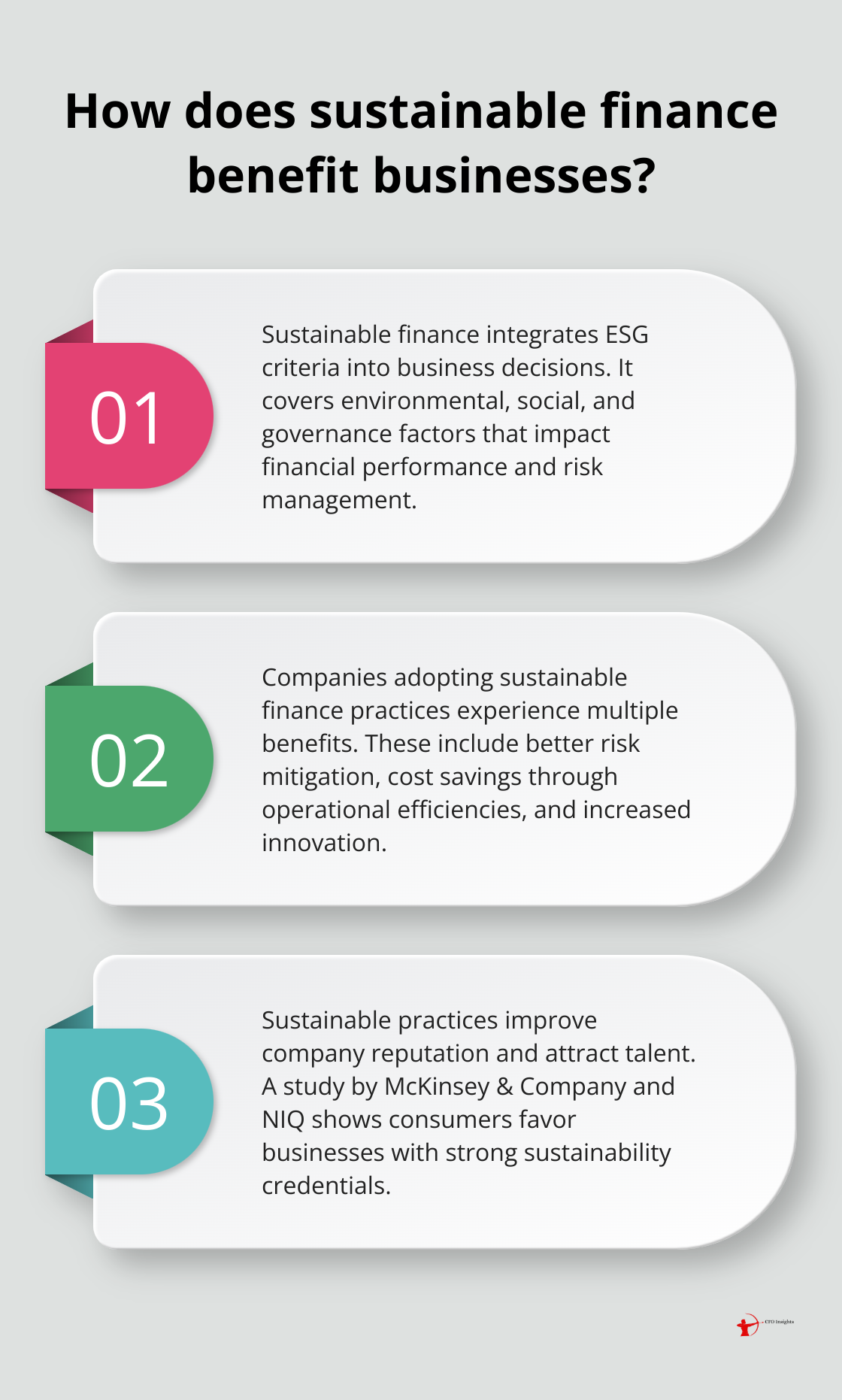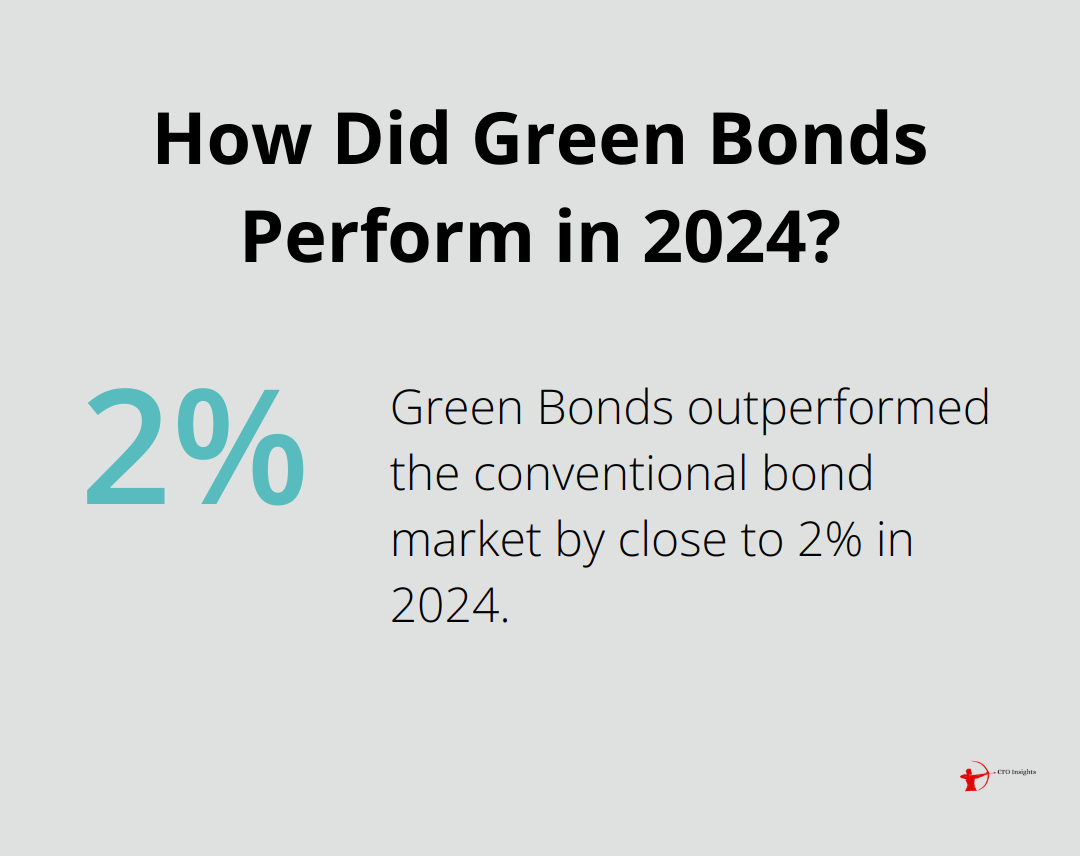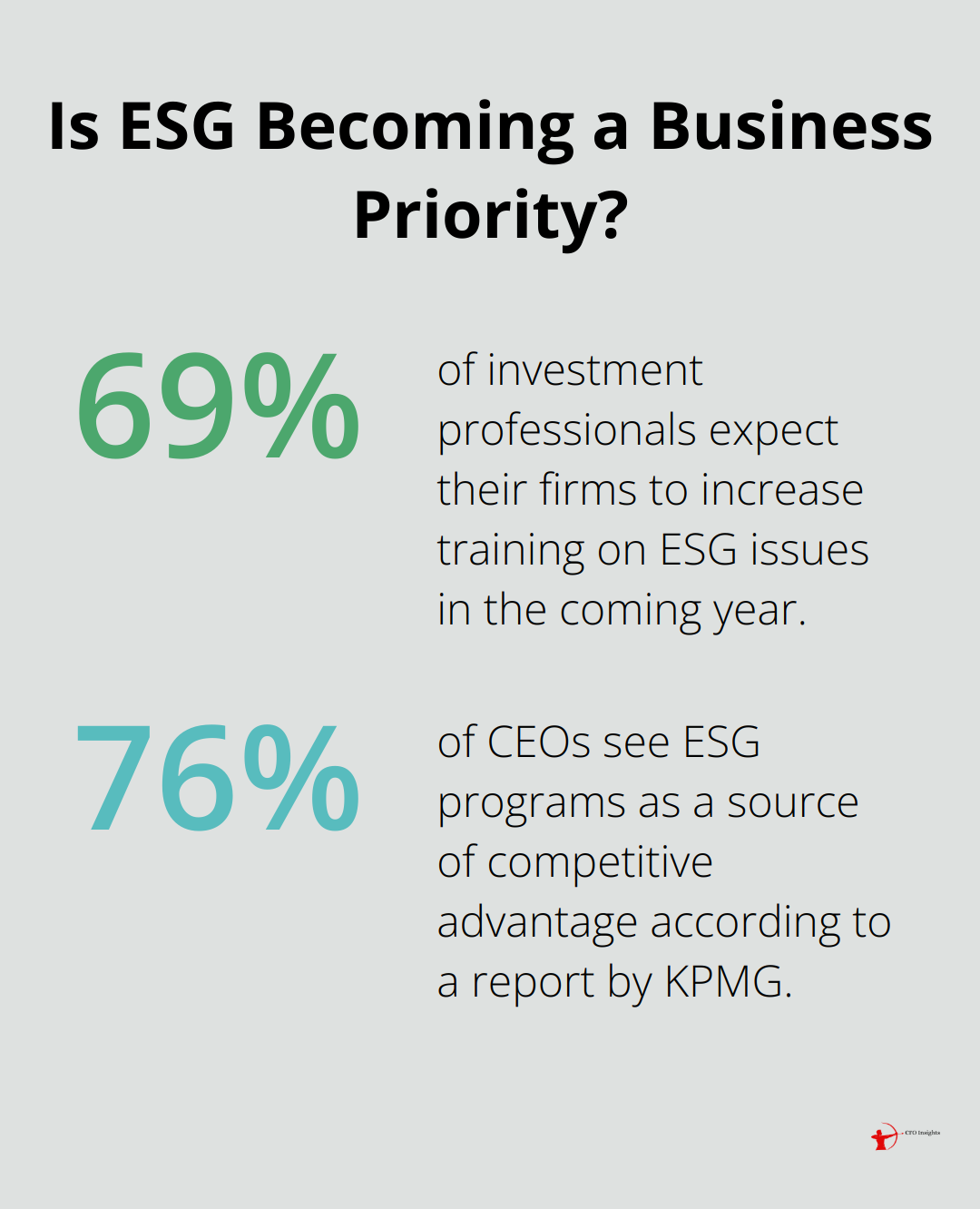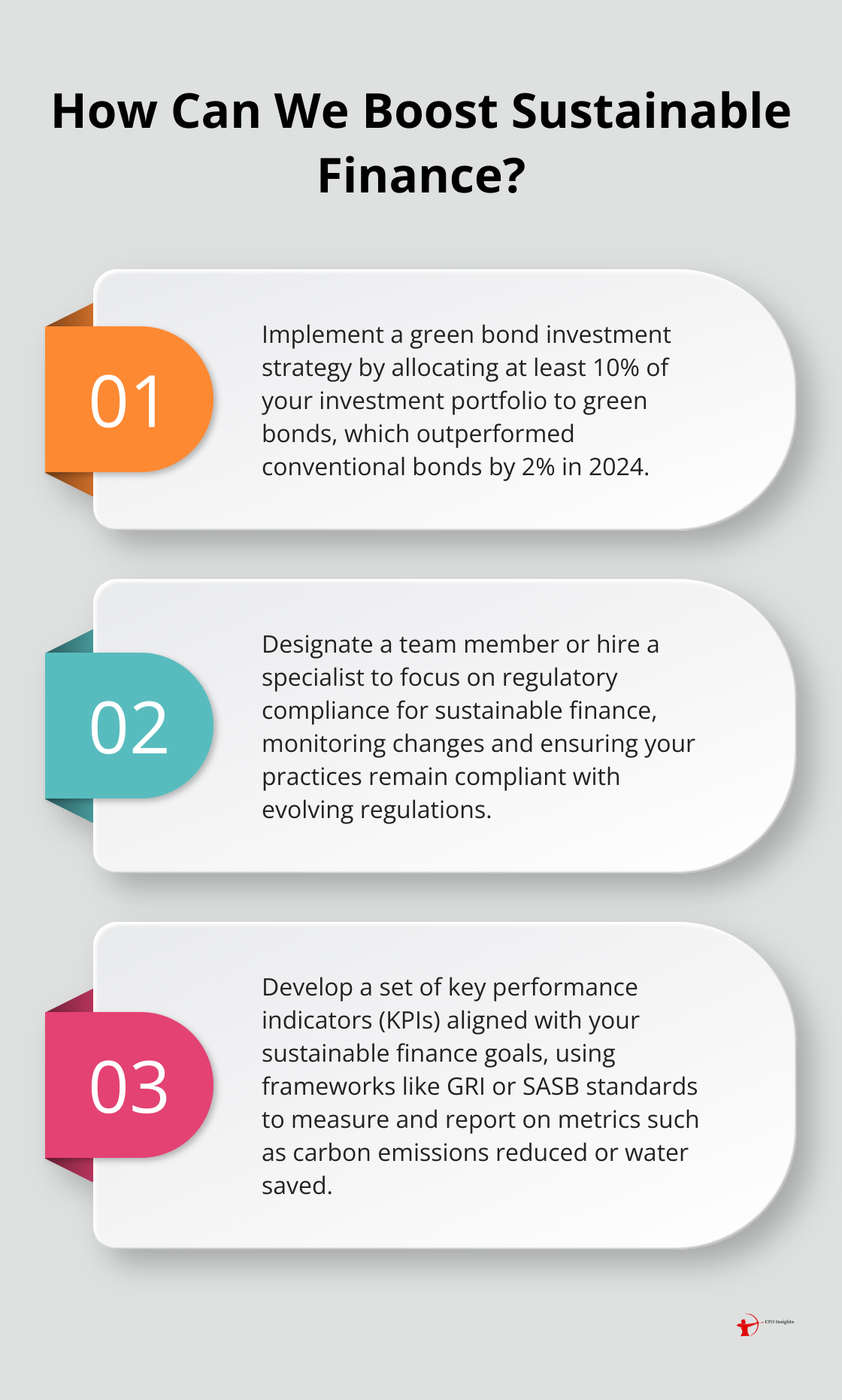Sustainable finance is reshaping the business landscape. At CFO Insights, we’ve seen a growing number of companies embrace this approach to create long-term value.
This shift goes beyond environmental concerns, encompassing social and governance factors that impact financial performance and risk management.
In this post, we’ll explore how to integrate sustainable finance into your business strategy, unlocking new opportunities and preparing for a future where sustainability is a key driver of success.
What is Sustainable Finance?
The Transformation of Business Finance
Sustainable finance revolutionizes the business landscape. It extends beyond environmental concerns, encompassing social and governance factors that impact financial performance and risk management.
Core Principles of Sustainable Finance
Sustainable finance supports economic growth while reducing environmental pressures and considering social and governance aspects. This approach reshapes how companies make financial decisions, from investments to operational strategies.
ESG Criteria: The Foundation of Sustainable Finance
ESG criteria form the cornerstone of sustainable finance. They help companies and investors assess risks and opportunities beyond traditional financial metrics.
- Environmental factors include climate change impact, resource use, and pollution.
- Social aspects cover labor practices, product safety, and community relations.
- Governance encompasses corporate leadership, executive pay, and shareholder rights.
Tangible Benefits for Businesses
Integrating sustainable finance into business strategies offers numerous advantages:
- Risk Mitigation: Companies that consider ESG factors better anticipate and manage risks. Businesses that assess climate change risks prepare more effectively for potential supply chain disruptions.
- Cost Savings: Sustainable practices often lead to operational efficiencies. Energy-efficient technologies can significantly reduce utility costs over time.
- Innovation Driver: The push for sustainability sparks innovation in products and services. Companies that develop eco-friendly solutions often discover new market opportunities.
- Improved Reputation: Consumers increasingly favor businesses with strong sustainability credentials. A joint study from McKinsey & Company and NIQ examines sales growth for products that claim to be environmentally and socially responsible.
- Talent Attraction: Working for a company with strong ESG principles is a priority, especially among younger generations. This gives businesses an edge in recruiting top talent.
The Role of Financial Expertise
Navigating the complex landscape of sustainable finance requires expert guidance. Fractional CFO services (such as those offered by CFO Insights) help companies integrate sustainable finance practices effectively. These services ensure businesses reap the benefits of sustainable finance while managing potential challenges.

As we move forward, the next section will explore how to implement sustainable finance practices in your business strategy, turning these principles into actionable steps for long-term success.
How to Implement Sustainable Finance Practices
Assess Your Current Financial Strategy
Start with a thorough review of your existing financial practices. Analyze your investment portfolio, operational costs, and risk management strategies. Identify areas where sustainability considerations are lacking or could improve.

For example, examine your energy consumption patterns. Many companies find significant cost-saving opportunities by switching to renewable energy sources.
Identify Sustainable Investment Opportunities
Explore potential sustainable investments that align with your business goals. This could involve allocating capital to green technologies, sustainable supply chain initiatives, or socially responsible projects.
Consider the growing market for green bonds. Green Bonds outperformed the conventional bond market by close to 2% in 2024, indicating a robust market for sustainable investments.
Develop an Integration Roadmap
Create a clear roadmap for successful integration. Outline specific steps, timelines, and responsible parties for implementing sustainable finance practices.
Start with quick wins to build momentum. For instance, implement energy-efficient lighting or optimize waste management to yield immediate cost savings and environmental benefits.
Gradually move towards more complex initiatives, such as integrating ESG criteria into your investment decision-making process or developing sustainable products. The transition to sustainable finance is an ongoing process that requires continuous improvement and adaptation.
Leverage Technology for Sustainable Finance
Embrace digital tools to support your sustainable finance initiatives. Advanced analytics and AI can help you track and optimize your ESG performance. For instance, blockchain technology can enhance supply chain transparency, allowing you to verify the sustainability credentials of your suppliers.
A report by PwC UK and Microsoft suggests it’s time to harness the power of AI to solve the world’s environmental problems. These technologies provide valuable insights for sustainable decision-making.
Seek Expert Guidance
Implementing sustainable finance practices requires expertise. Consider partnering with a fractional CFO service (such as CFO Insights) to guide you through this complex process. These services ensure businesses reap the benefits of sustainable finance while managing potential challenges effectively.
As you embark on your sustainable finance journey, you’ll likely encounter various obstacles. In the next section, we’ll explore common challenges in sustainable finance integration and strategies to overcome them.
Tackling Sustainable Finance Hurdles
Bridging the Knowledge Gap
One of the primary challenges in sustainable finance integration is the lack of consistent ESG data. Many organizations struggle to understand the complexities of ESG criteria and how to apply them effectively.

Companies can invest in training programs for their finance teams to address this issue. A survey by the CFA Institute indicates that 69% of investment professionals expect their firms to increase training on ESG issues in the coming year.
Another effective strategy involves partnering with experts. Fractional CFO services (like those offered by CFO Insights) can provide the necessary expertise without the cost of a full-time hire. These professionals bring valuable insights and experience in sustainable finance practices, helping companies navigate this new terrain more effectively.
Aligning Stakeholder Expectations
Different stakeholders often have varying expectations when it comes to sustainable finance. Shareholders may prioritize short-term profits, while customers and employees might push for more aggressive sustainability measures.
To manage these diverse expectations, transparency is key. Regular communication about your sustainable finance initiatives, their progress, and their impact can help align stakeholders. Try to publish an annual sustainability report that clearly outlines your goals, actions, and results.
It’s also important to demonstrate the financial benefits of sustainable practices. A study by NYU Stern Center for Sustainable Business found that sustainable products achieved a 5-year CAGR of 9.9%. Sharing such data can help convince profit-focused stakeholders of the value of sustainable finance.
Navigating the Regulatory Maze
The regulatory landscape for sustainable finance is complex and ever-changing. Keeping up with new regulations and reporting requirements can challenge many businesses.
To stay ahead, consider designating a team member or hiring a specialist to focus on regulatory compliance. This person can monitor changes in regulations, assess their impact on your business, and ensure your sustainable finance practices remain compliant.
Collaboration with industry peers can also benefit your organization. Joining industry associations or sustainability-focused groups can provide valuable insights into regulatory trends and best practices for compliance.
Companies that proactively adapt to new regulations often gain a competitive edge. A report by KPMG found that 76% of CEOs see ESG programs as a source of competitive advantage.
Overcoming Resource Constraints
Limited resources (both financial and human) can hinder the implementation of sustainable finance practices. Small and medium-sized enterprises often face this challenge more acutely.
To overcome this hurdle, start small and scale up gradually. Identify low-hanging fruit (such as energy efficiency measures) that can provide quick wins and generate savings to fund further initiatives.
Consider leveraging technology to streamline processes and reduce the resource burden. Automated ESG reporting tools, for instance, can significantly reduce the time and effort required for data collection and analysis.
Measuring and Reporting Impact
Quantifying the impact of sustainable finance initiatives can prove challenging. Traditional financial metrics may not capture the full value of these efforts.
Develop a robust set of key performance indicators (KPIs) that align with your sustainable finance goals. These might include metrics like carbon emissions reduced, water saved, or social impact created.
Utilize established frameworks like the Global Reporting Initiative (GRI) or the Sustainability Accounting Standards Board (SASB) standards to guide your reporting efforts. These frameworks provide a structured approach to measuring and communicating your sustainable finance performance.
Final Thoughts
Sustainable finance reshapes the business landscape by integrating environmental, social, and governance factors into financial decision-making. Companies that adopt these practices often improve risk management, save costs, and enhance innovation. They also attract top talent and enjoy a stronger reputation among consumers and investors.

The long-term advantages of sustainable finance extend to businesses and society. It provides a framework for addressing global challenges like climate change and social inequality while driving economic growth. Sustainable finance encourages responsible resource management, fosters social equity, and promotes good governance practices that benefit all stakeholders.
CFO Insights understands the complexities of implementing sustainable finance practices. Our fractional CFO services provide expertise and guidance to navigate this transition effectively. We work closely with businesses to develop tailored strategies that align with their unique goals and challenges, ensuring smooth integration of sustainable finance principles.
5 thoughts on “Integrating Sustainable Finance into Your Business Strategy”
Leave a Reply
You must be logged in to post a comment.





[…] will explore how to implement this framework effectively within your organization, ensuring that risk management becomes a cornerstone of your decision-making […]
[…] As we move forward, we’ll explore the tangible benefits that effective stakeholder mapping can bring to your business growth strategy. Understanding who your stakeholders are is just the first step; the real value comes from how you use this knowledge to drive your business forward. […]
[…] chapter will explore how finance professionals can leverage technology and data analytics to drive strategic decision-making and further enhance their leadership […]
[…] Companies that proactively adapt to new regulations often gain a competitive edge. This is particularly true in the realm of data management and analytics, where regulations are constantly evolving. Stay informed about changes in data protection laws and industry-specific regulations to ensure your data-driven strategies remain compliant and effective. […]
[…] how sustainable finance practices can be integrated into your business strategy. This article on integrating sustainable finance into your business strategy provides valuable insights on how to align financial decisions with environmental and social […]